#TBT Seiko 6139 Pogue Chronograph
Pogue Chronograph
If asked by a vintage watch collector who mainly focuses on Swiss watches for a recommendation on one Japanese chronograph to add, my answer is always the same and without hesitation: a Seiko 6139 Pogue. Astute collectors of the brand might find that a little surprising amongst so many well known and, in certain cases, more traditionally styled watches that I opt for a very 70’s looking chronograph. Of course I have my reasons and let’s get into them…it’s #TBT time!
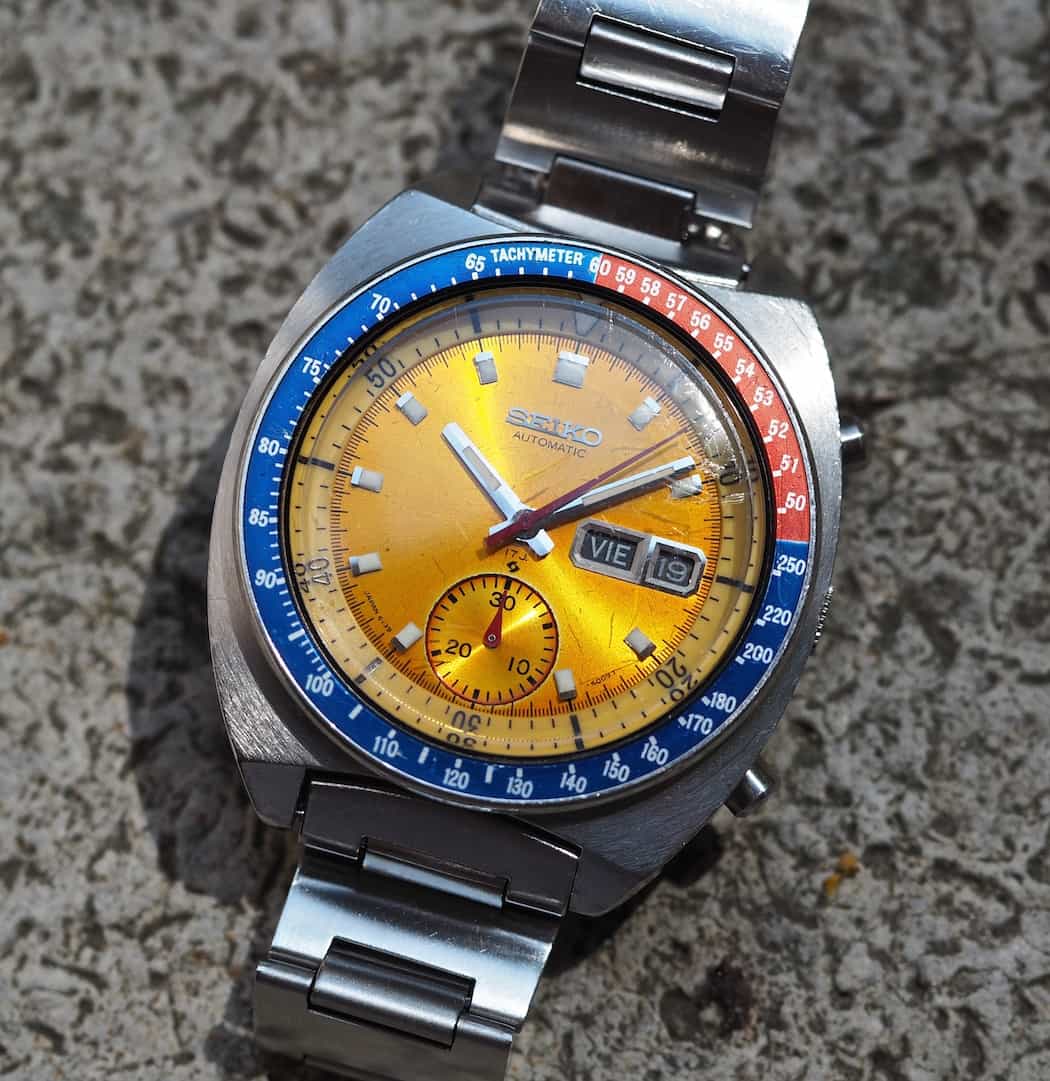
The yellow dial of the Seiko 6139 Pogue truly radiates in the light
Seiko 6139 – A Landmark Chronograph
The 6139 was Seiko’s initial foray into the automatic chronograph game and actually debuted in 1969 alongside the Zenith El Primero and the multi-branded Caliber 11. I actually covered a later 1970’s version in one of my earliest articles in a head to head challenge against a Zenith A386. The watch in front of you, from 1972, was one of the original case designs (aside from a small indentation in the crown area) that came out in 1969 alongside several other 6139 case variations and it was made until roughly 1976. Dial choices were yellow, silver and blue and loads of variants were produced as far as dial markings, bezel colors and bracelets during the model’s history. For an exhaustive history on the model, head here. For me, though, the semi-psychedelic yellow dial is the most significant.
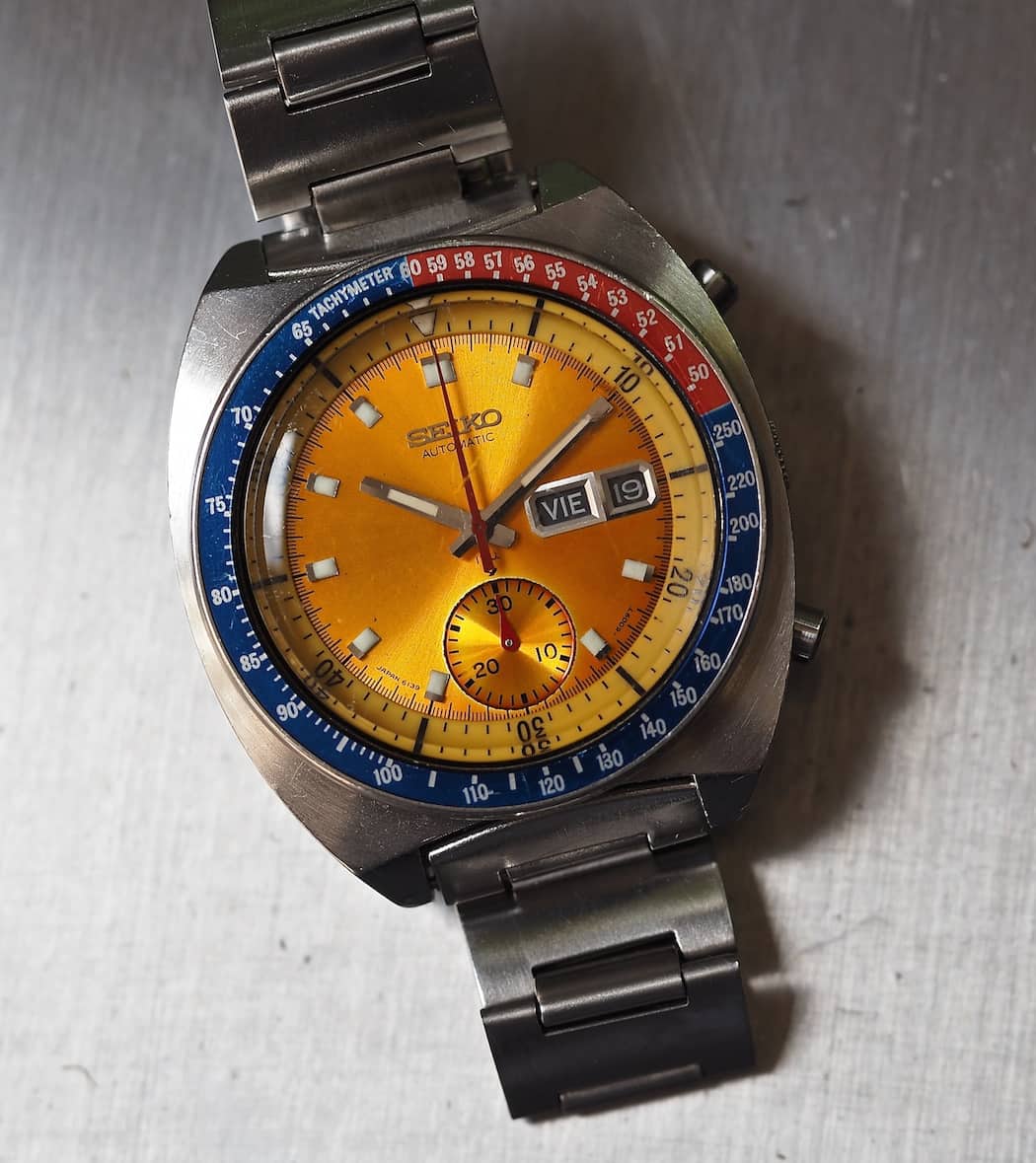
The Seiko 6139 Pogue – a watch worn in space for roughly 84 days
The 6139 was in space for 84 days!
If you’re not aware of how the Seiko 6139 Pogue obtained its nickname, it’s a great story. NASA selected USAF pilot Colonel William Pogue in 1966 as one of the original astronauts for the Apollo Program. He was actually chosen for the aborted Apollo 19 mission, but was then transferred to the Skylab program. And so it was in late 1973 into 1974 (the mission lasted over 84 days), that Colonel Pogue went into space as a part of Skylab 4.
Instead of Speedmasters
Interestingly, while Pogue was testing prior to the launch, he needed a chronograph due to the fact that Speedmasters were not issued until very close to the mission launches. Pogue ended up buying; you guessed it, a Seiko 6139 with a yellow dial and, thus, the nickname for this historic chronograph. Significantly, this was the first automatic chronograph in space and in case you were wondering, it performed flawlessly.
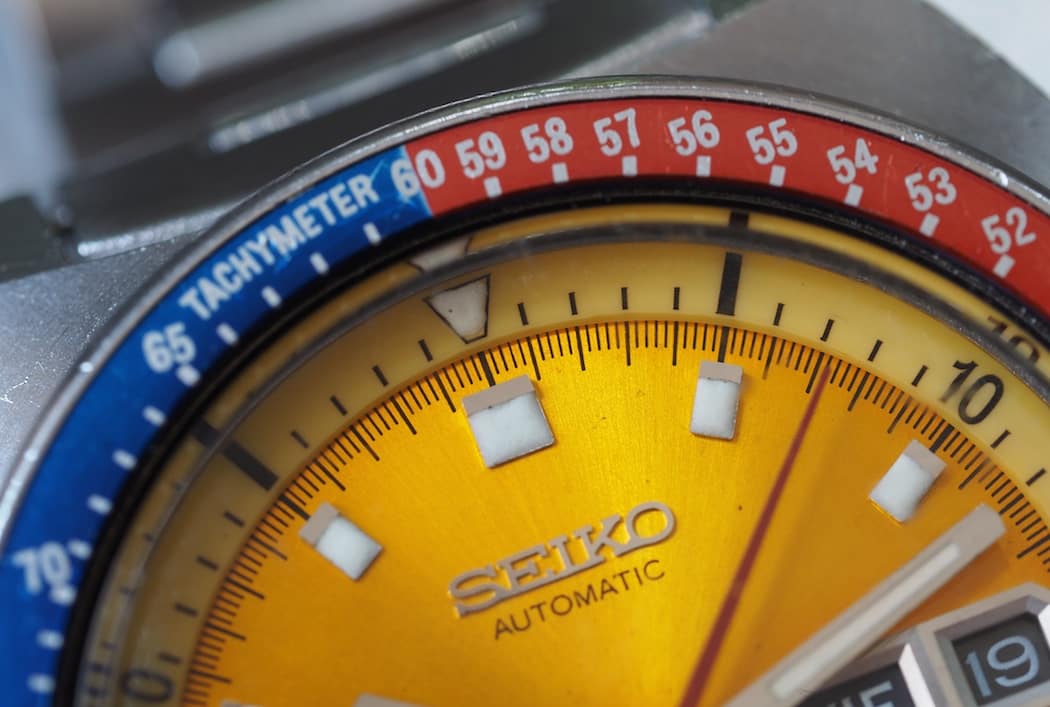
The rotating internal bezel – these often fade heavily to near white
Seiko 6139 Pogue Variants
The Seiko that Col. Pogue purchased was actually a 6139-6002 and it differs ever so slightly from the piece that I own due to its script on the dial at 9:00 stating its 70m of water resistance. Furthermore, you’ll see that Pogue’s watch contained a white inner bezel. Guess again because it’s actually yellow but faded like many did over time. My Seiko 6139 Pogue is actually a 6139-6005 and is one of several 6139-600x models that the brand issued. The “x” actually denotes numbers used to signify models meant for different markets and the 6005 I own was apparently a US-market piece.
Yellow
Seiko collectors, while being sticklers for originality like any watch group, have been fairly generous by calling any yellow-dialed 6139 a “Pogue” and when we discuss the market, you’ll note that there’s not a huge amount of price variation amongst the models. Time will tell if this continues, but from what I’ve seen, you can at least call your 6139 a “Pogue” provided that it’s yellow.
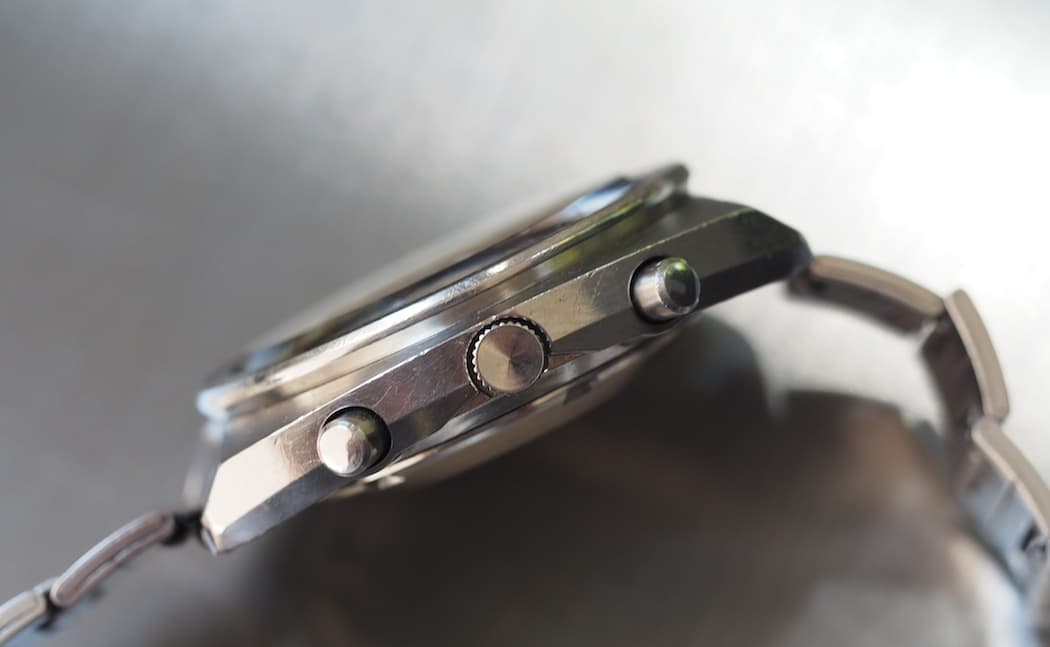
A look at the Seiko 6139 Pogue case from the side shows many surfaces
Seiko 6139 Pogue Details
Coming to the Seiko 6139 Pogue in detail, the watch features a shape that is mildly in the 1970’s c-case shape used by so many brands. It’s fully stainless steel and is roughly 40mm in diameter and contains 19mm lugs. Design-wise, it actually contains a fair number of surfaces and finishes – something that can’t be said of all Swiss contemporaries from the era.
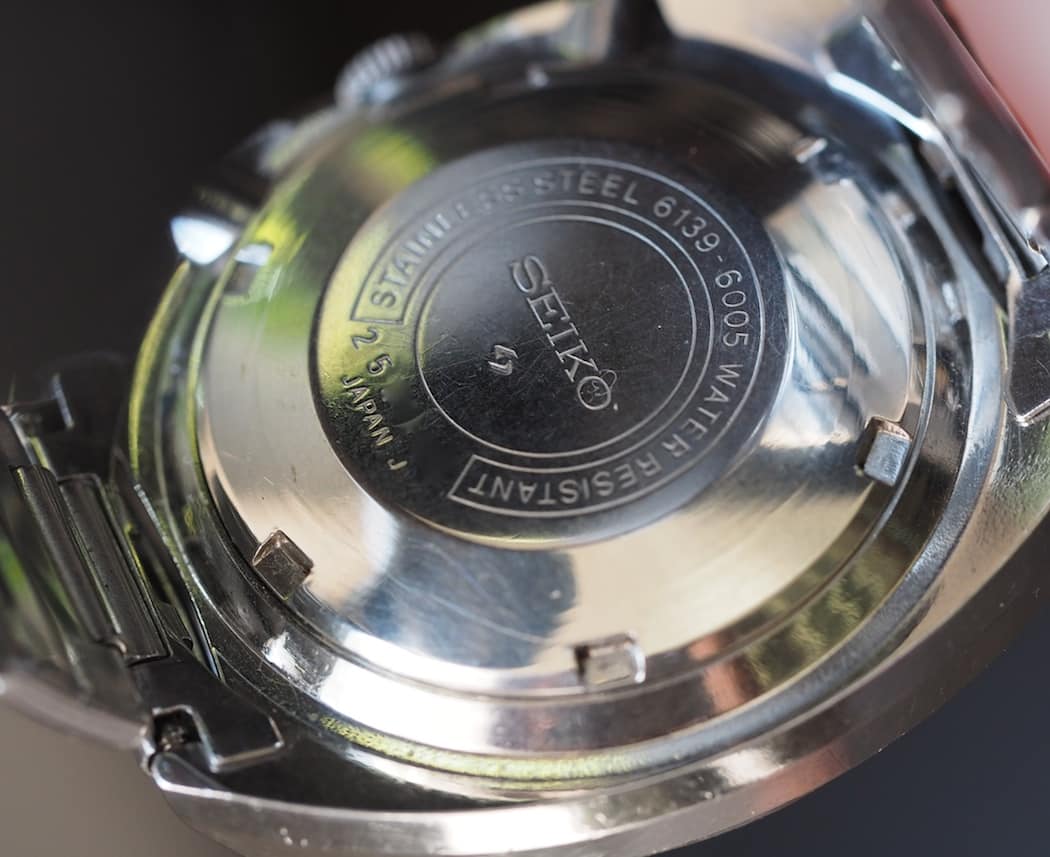
The Seiko 6139 Pogue case back – this model is from May, 1972
Caseback
Flipping the watch over shows a large screw-down case back and some highly sculpted tubes that allow for the fitment of the pushers. Here again, it’s a nice design that doesn’t appear to scream “cost cutting” as the Swiss-only collector crowd might have you believe.
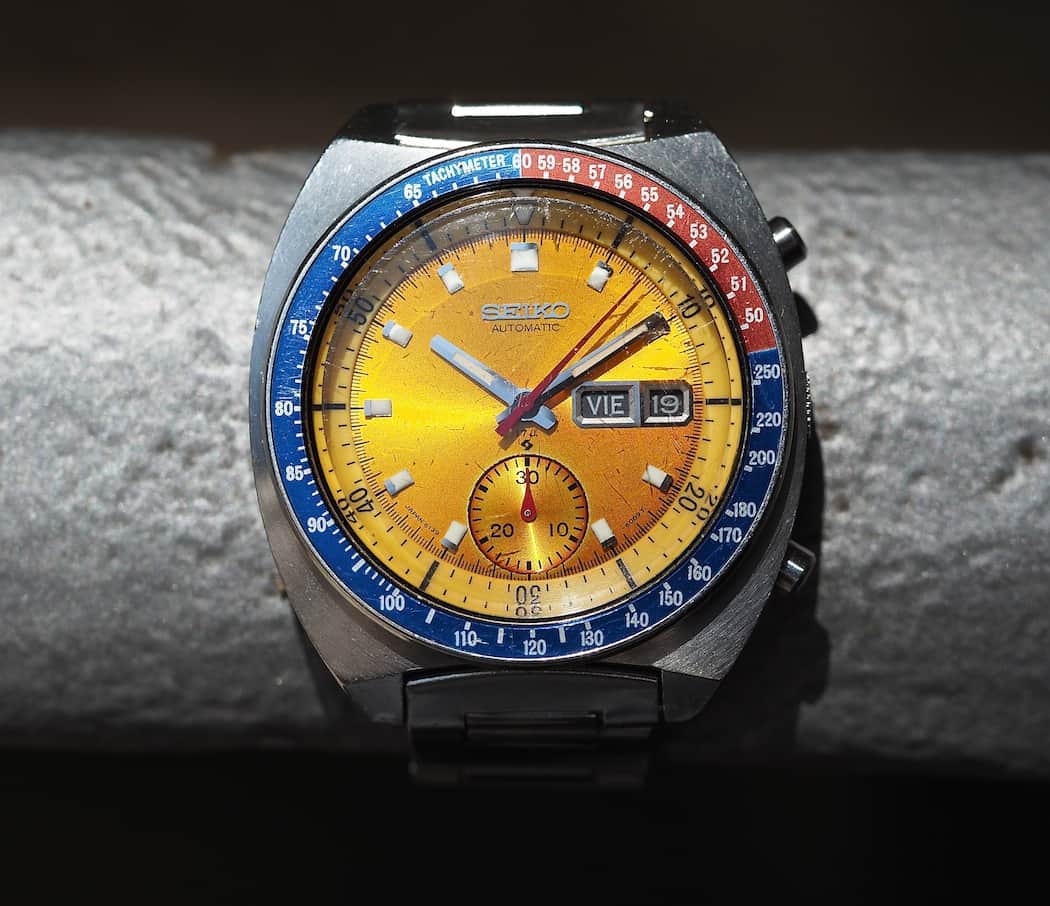
The bold colors of the Seiko 6139 Pogue make it a real favorite
Bright Colors
The characteristics I enjoy so much about the Seiko 6139 Pogue are most certainly the colors. Starting outside, the Pogue has a bright blue and red tachymeter bezel. This contrasts wonderfully – in such a 70’s way – with the bright yellow sunburst dial. Now, to be fair, when I first saw these watches five or so years ago, I thought they looked incredibly passé. However, credit the space history and the fact that these watches were always being discussed on forums, and I was hooked. I simply had to have one of these brightly lit beasts on my wrist.
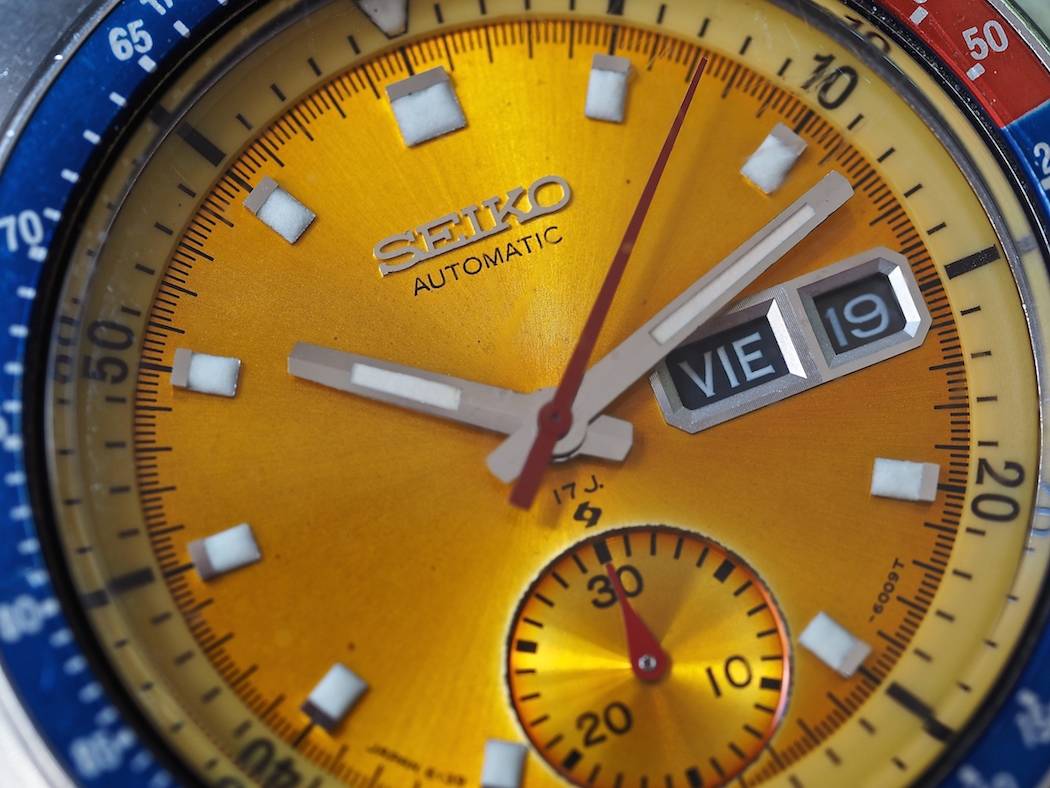
A look at the Seiko 6139 Pogue close up shows details such as the applied logo and the Suwa symbol
Dial and Bezel
Other details abound on the Seiko 6139 Pogue such as the equally bright yellow internal bezel; it’s adjusted smoothly via the flush mounted crown at 3:00. Move on to the simple hour and minute hands that look absolutely clinical next to the bright red central chrono hand and teardrop shaped 30-minute counter. Applied, lumed hour markers run along the dial with the only gap being the day/date window with bold metal bezel. In the macro above, you can even see the wild texture on this small bezel – fascinating stuff that I hadn’t noticed during the several years of ownership prior to shooting the watch. Also note an applied Seiko logo and the inclusion of the “Suwa” factory symbol right below the center of the dial.
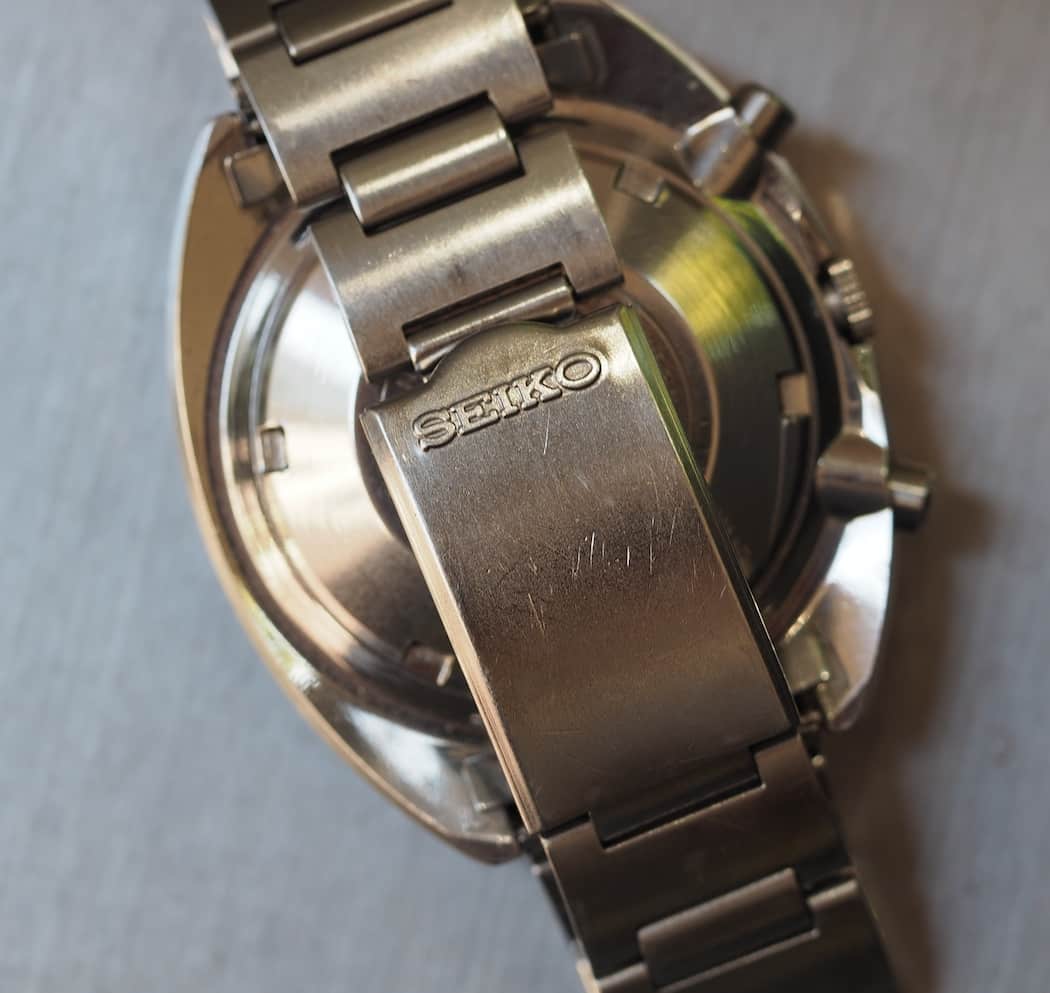
The H-link bracelet as found on the Seiko 6139 Pogue
Hardlex
Other things to note are the overall height of the watch. As this was a fully integrated chronograph movement (not modular), it’s much thinner than the beefy caliber 11. In fact, I’d say that watch thickness is well in proportion with the overall size of the watch. Furthermore, unlike most of its competitors of the time, the Seiko 6139 Pogue contains a Hardlex mineral glass crystal instead of acrylic. I actually made the choice to leave the original, albeit scratched, crystal on the watch after its service. The bracelet on the watch is a simple, “H-link” bracelet that is original to the watch with fitted, stamped end links. It clasps much like a non-diver Rolex bracelet from the era, but is noticeably lighter. It is very comfortable, though, and is adjusted with relative ease via sliding and locking tabs that can be removed from the links.
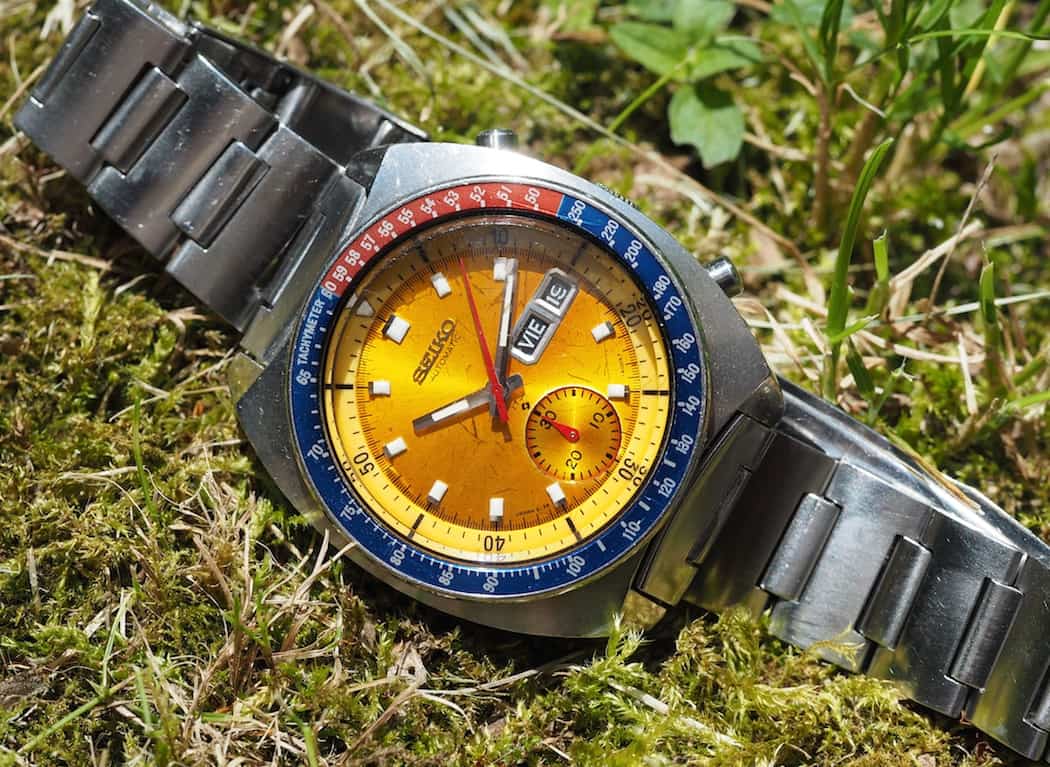
The Seiko 6139 Pogue in the sun
A simple chronograph
Using the Seiko 6139 Pogue, or any 6139 for that matter, is a relatively simple affair. Unlike its slightly later relative, the 6138, the column wheel 17-jewel, 6139b movement cannot be hand wound. The crown pulls out one detent for time setting, but it pushes in (it is spring loaded) two levels in order to change the day and date. Essentially, pushing all the way in changes both, so it’s wise to first secure the day and then to focus on the date. You’ll also see that the date wheel in this model is in Spanish and English, which helps to further confirm the market destination for the 6005. Finally, the pushers work per normal with the top button providing stop/start duty and the lower resetting the register and central hand.
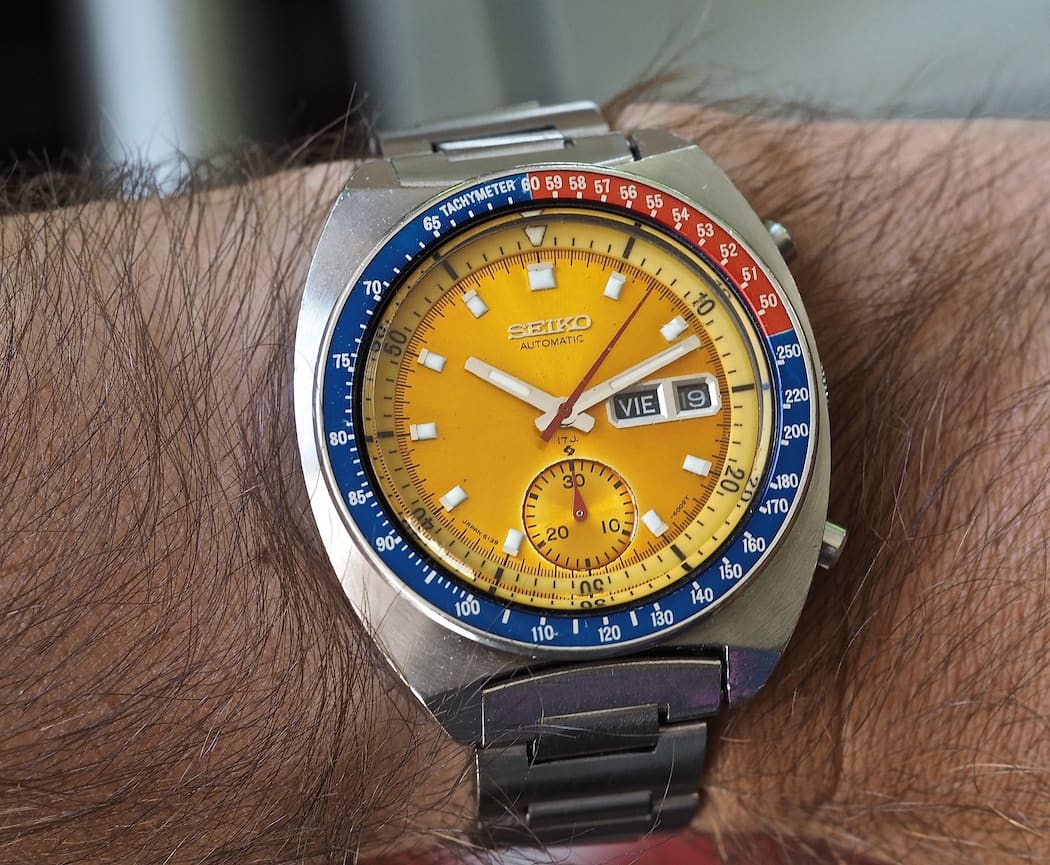
The Seiko 6139 Pogue on the wrist
A Great Daily Wear…
I found the Seiko 6139 Pogue you see here on eBay over four years ago and it cost roughly $180. It arrived in good working condition, but it was clear that it had lived a real life and hadn’t seen a service in many years. I picked the watch up in the middle of a very steamy Pennsylvania summer and I recall putting the watch on inside of an air-conditioned house and then walking outside only to see the dial fog up immediately.
Comfortable and Lightweight
So, yes, it was time for a service and replacement of all the seals. A couple months later I had the watch back and it’s run flawlessly ever since. It wears perfectly on my smaller wrist but obviously has loads of presence due to its dial colors. I wear it to work, casually or wherever – it’s very comfortable and relatively lightweight.
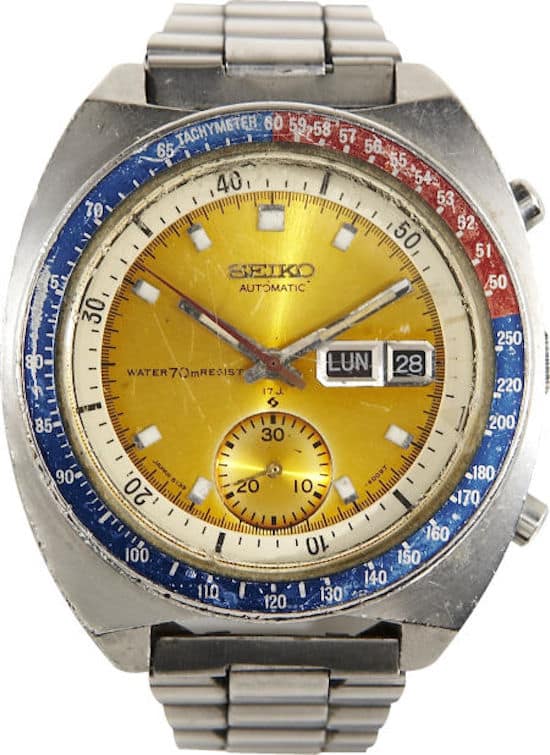
Col. Pogue’s original Seiko 6139-6002 as sold in 2008 for roughly $6000 (photo credit: By Doomguy10011 – Own work, CC BY-SA 4.0)
Pogue Market
Availability
Vintage Seiko chronographs are still fairly plentiful on the market, but as I always remind people, it’s quality not quantity and there are a lot of bad vintage Seiko chronographs on the market. Aftermarket bezels, wrong hands, non-working inner bezels, and loads of moisture intrusion are par for the course and the Seiko 6139 Pogue is no exception. Movements are very robust, but sometimes finding a watchmaker who will work on them can be a difficult task.
Prices
Oh, and back to that internal bezel – if the plastic teeth on its underside are stripped, you’ll left sourcing an aftermarket part. Also, as I mentioned before, original bezels are prone to fading, so it purely comes down to your preference for patina. Cost wise, good Pogues seem to sell for $350 – 700, which certainly represents an increase over the last several years. At the $350 level, if a good one is found, I truly think this is a steal. Speaking of which, Col. Pogue’s used watch sold for roughly $6,000 at auction in 2008. Can you imagine what it would garner today?
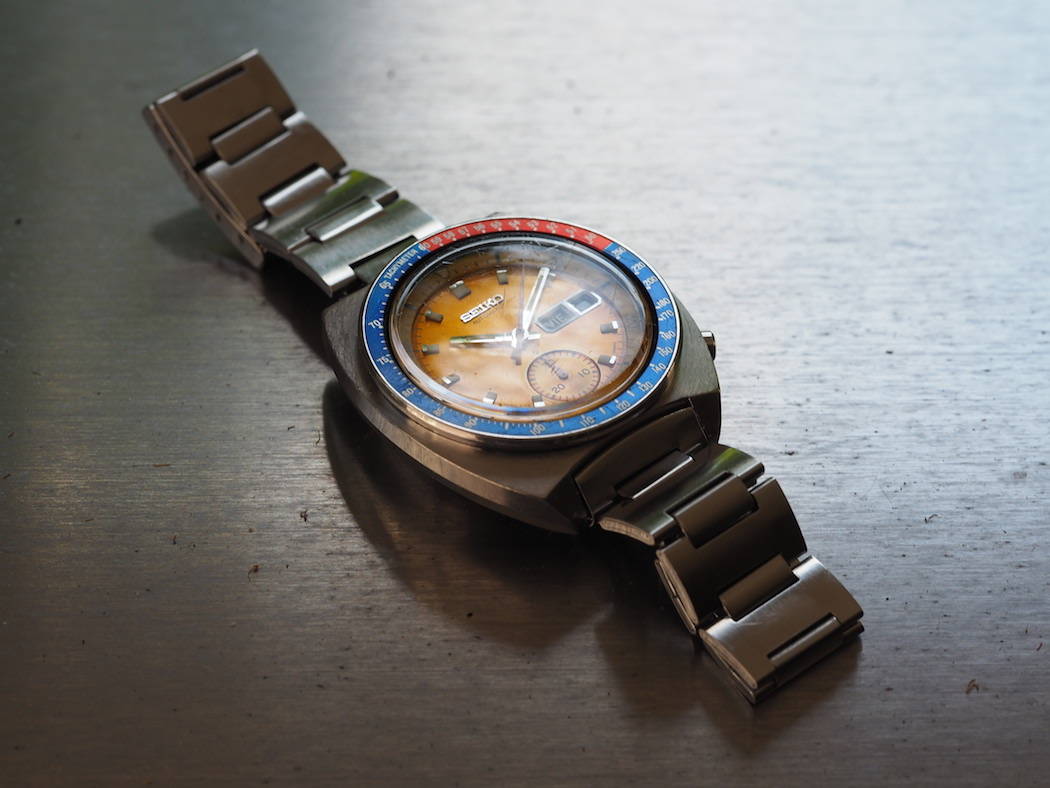
A complete look at the Seiko 6139 Pogue with its folded bracelet
I hope you enjoyed a brief look at the Seiko 6139 Pogue. It’s a legendary watch that can be had for a relative pittance versus so many other vintage chronographs. In fact buying a decent one is similar to the cost of a service for some chronographs! Let us know if you own a Pogue and what you think of this brightly colored watch. Until next week…

















